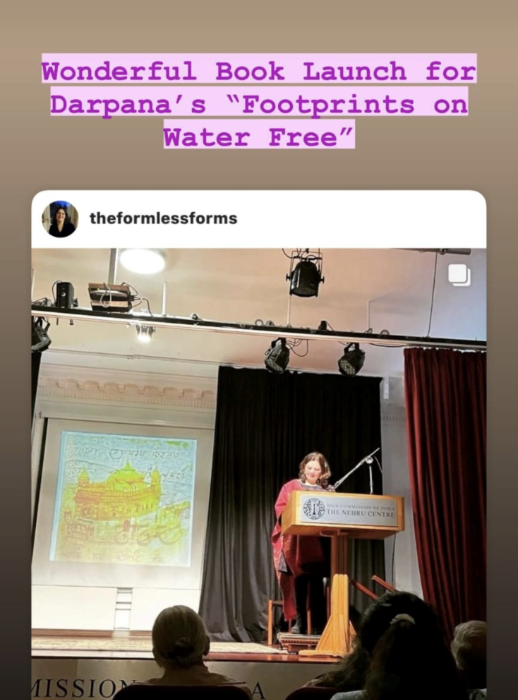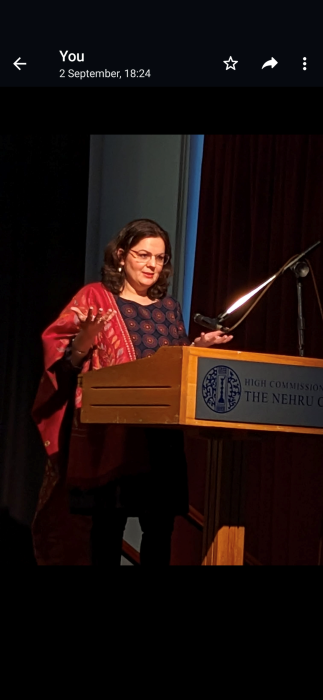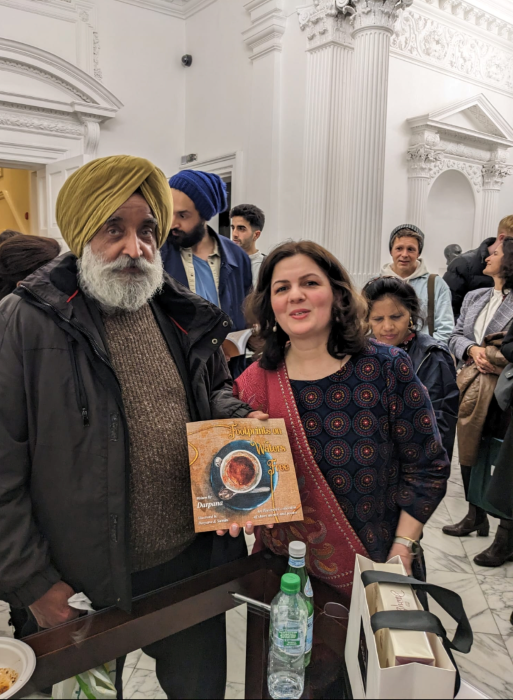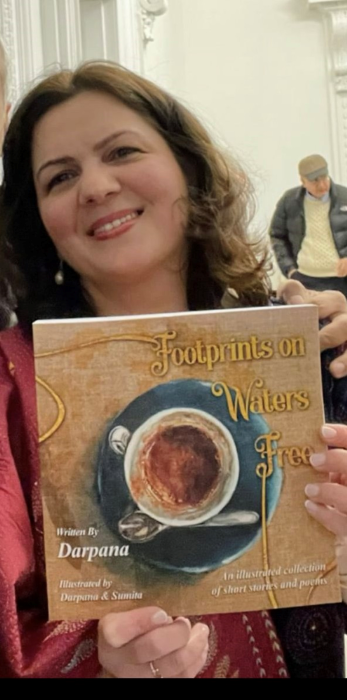(Samaj Weekly)

TARLOCHAN SINGH VIRK INTERVIEWED THE AUTHER DARPANA RATHORE
 Where did you get your education from?
Where did you get your education from?
I hold a master’s degree in history from Mumbai University, India and a second Master’s in Comparative Religious Studies, specializing in Gurbani, from World Sikh University London. Additionally, I have been creating art since childhood and learned it from my mother, who was an art teacher. I have also undertaken several courses at institutes such as the Prince’s School of Traditional Art.
- Tell me a bit about yourself.
Well, the message of the book illuminates the concept of Oneness, suggesting that there is no individual presence. However, to deny it is also a form of belief, if it is not explicitly spoken from nothingness. I was born and brought up in Mumbai and moved to the UK years ago. Fascinated by the scriptures, I delved deep into their understanding, but I always felt that their true meaning was either lost in translation or that they were attempting to convey something far deeper than what we have been conditioned to believe.
During my study of Hindu scriptures, I bothered my teacher, Dr. Shastry, expressing my disagreement with the theories of life after death, reincarnation, and karma as presented in the scriptures. I even shared the translations I had done of the Bani with him. In response, he stated that akin to Valmiki, I had to die in the depths of love so that the essence of the scriptures could be revealed.
Eventually, Dr. Shastry directed me to Tony Parsons (https://www.theopensecret.com/) to seek answers to my questions and to recognise the essence of the scriptures. With Tony, I didn’t find answers to my questions; instead, the questions themselves simply vanished. The essence of the scriptures was unravelled, revealing the ever-present oneness.
 Why is it important to learn your mother tongue Punjabi?
Why is it important to learn your mother tongue Punjabi?
The essence of this message conveys that nothing holds inherent importance in life, as life simply exists as it is. However, I discovered that through my mother tongue, Punjabi, I was able to truly comprehend and unravel the profoundness and intricacies of Gurbani—the Guru’s message. Furthermore, our Punjabi literature is exceptionally profound and deserves to be read and shared. Language serves as the bridge that connects us to cultural traditions, conveys the fundamental messages of literature and spiritual works. Translations of works in other languages often fall short in capturing the true essence, tone, and subtleties of a particular language. Hence, for individuals with a Punjabi heritage who seek to understand its traditions, literature, and scriptures, it becomes crucial to learn Punjabi to fully embrace its richness and depth.
- How did you choose the name of the book?
The title of the book is derived from the last line of the verse “The Enlightened Tea” (poem 2) within the book. Tony proposed this title, as it encapsulates the paradoxical nature of the book’s message and resonates with the essence of scriptures.
- How long did it take you to write the book and why?
The process of writing the book took approximately 9 years. I am not sure why it took so long but the verses flowed naturally, often arising in unexpected moments such as the middle of the night, during drives, or even while cooking. I would capture these verses either by recording them on my phone or by enlisting someone nearby to jot them down.
Publishing the book also demanded a significant amount of apparent time. Creating the artwork featured within the book, including the detailed Golden Temple painting – which itself took over 6 months to complete – contributed to the prolonged timeline. Moreover, designing the book, arranging for photography, incorporating copy edits, and addressing publishing and technical aspects all required months of dedicated effort.
The intricate process of bringing the book to fruition encompassed not only the act of writing itself but also the meticulous completion of various artistic, design, and publishing elements.
- If you have written before, please give details.
Before this book, I translated Gurbani on my blog.
https://onenessinsikhism.wordpress.com/
- Who inspired you to write the book if anyone?
The inspiration to write this book came naturally, without any specific influence. Taking ownership of its creation would be arrogant, as expressed in Gurubani’s verse, “Tu karta karna main nahin jau haun kari na hoi …” Thus, I wrote the verses as they spontaneously emerged.
- Who is the book mainly aimed at?
This book caters to all sensitive individuals who ponder the mysteries of life. It resonates with teenagers who challenge societal norms, philosophers who delve into the essence of existence, seekers who yearn for their own dissolution, and the enchanting melody of unconditional love. It speaks to immigrants in search of a sense of belonging and home. Art enthusiasts who embrace innovative expressions and avid readers of scriptures will find solace within its pages. Additionally, it extends an invitation to critics to engage with its abundant material for assessment and analysis.
In essence, this book is for anyone seeking an enjoyable read, captivating a wide range of individuals with its thought-provoking and multi-dimensional content. Essentially, it is a book for anyone who simply wishes to indulge in a captivating and enlightening reading experience.
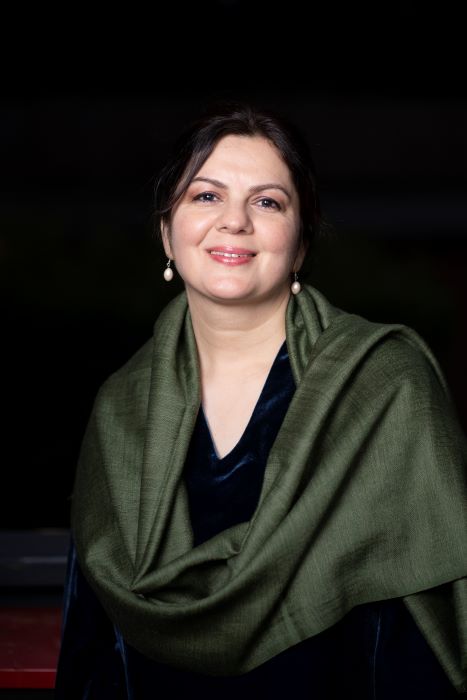 When is your next book due?
When is your next book due?
Let’s see, my next book will feature a translation of the first 14 pages of the Guru Granth Sahib, encompassing the Japji, the Rehraas Sahib, and Sohaila. I am currently in the process of creating the artwork for the book, with four paintings remaining to be completed. Furthermore, I am refining the translation of the Bani.
- Would you like to add anything else?
In essence, Gurbani conveys that all there is Oneness or the formless forming (Niraakar Aakar) appearing as everything. The concept of individual control is a perception rooted in duality, yet it too is an expression of the same Oneness. I kindly request your support for the book by purchasing it and spreading the word. Titled “Footprints on Waters Free,” the book showcases exquisite handmade art created by my mother and myself. It is currently available on Amazon and will soon be released worldwide in both hardcover and paperback editions. If you resonate with the message of Oneness and would like to connect, please feel free to reach out to me at theformlessforms@gmail.com. I also hold sessions on Oneness, and you are all warmly invited to join.
Thank you so much for this interview.
Regards,
Darpana
